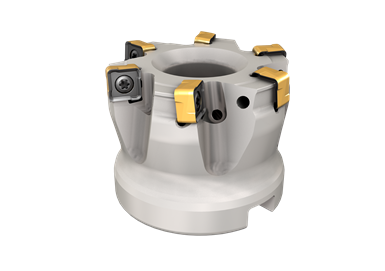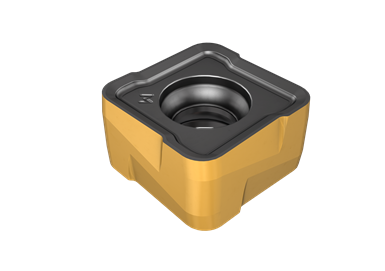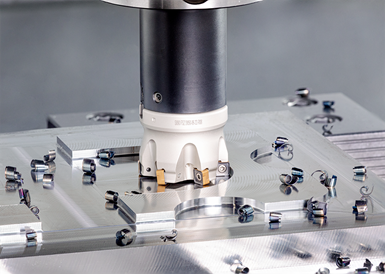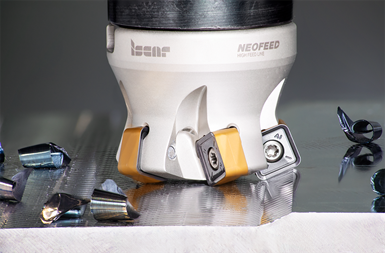A More Efficient Way to Cut Near-Net Parts
Sponsored ContentChoosing the right milling insert is important: This insert from Iscar is designed for finishing near-net shaped parts quickly, while another makes high-feed machining more accessible with existing machining centers.
Share
Manufacturing is a competitive industry in which machine shops across the world struggle to make parts more efficiently than their neighbors. This leads to new technologies improving machine performance often creating more complex parts for shops to cut. In this environment, something as simple as knowing the right cutter for the right job can give a shop the edge.
Cutting Near-Net Shaped Parts With a True 90-Degree Insert
The NEO-DO S890 is designed to enable the operator to perform both roughing and finishing passes without having to change tools. The small inserts are ideal for making precise passes on parts with near-net shapes.
The automotive industry has embraced light-weighting, increasingly looking for manufacturers capable of producing near-net shaped parts, either from precision forged metals or in finishing processes for additive manufacturing (AM). Complex part designs are quickly becoming standard, but as much as complex shapes can benefit the final product, these shapes are thinner than those of most prismatic parts, which means there is less wiggle room in the cutting forces a machine applies to the part.
One easy-to-control factor that can improve the reliability and accuracy of milling these features is the cutting tool. Cutting tools with 90-degree lead angles generate radial cutting forces that transfer more of the cutting energy away from the part. This makes them ideal for parts with thinner walls or near-net shapes, as well as for parts with less rigid fixturing. Knowing that near-net and 3D-printed parts are growing more common, Iscar recently developed a square insert designed for finishing complex parts.
As a double-sided square insert, the NEO-DO S890 has more cutting edges than any other 90-degree milling insert Iscar provides. This makes it an economical choice for finishing near-net shaped parts..
The NEO-DO S890 is a 90-degree, double-sided, square milling insert from Iscar designed for combination applications, i.e., face and shoulder milling, and finishing near-net shaped components. “One of the challenges of designing a true 90-degree square insert is having enough axial clearance on the bottom of the insert so you’re not rubbing too much,” says Iscar National Product Manager - Milling, Bryan Stusak. “The geometry of this insert enables a true 90-degree angle while increasing the number of edges per insert over our previous offerings.” The true 90-degree angle, combined with a 0.200-inch maximum depth of cut makes this ideal for making finishing passes, especially on complex parts. “Printed and near-net shaped parts have very little material to remove,” says Stusak. “This insert is ideal for that environment, as it enables the cutter to make precise passes while minimizing the potential for damaging the part especially where there are workpiece or work holding fixture constraints.”
It is also worth emphasizing that this is not a nearly 90-degree cutter, but a true 90-degree cutter. “There are other square inserts that provide an 88- or 87-degree lead angle,” says Stusak. “This means that after roughing the part, the user has to go back over it to achieve the 90-degree angle required by the specs.” The NEO-DO S890 enables the operator to perform a roughing and finishing pass on the part without having to change tools or go back over the same passes again. This saves both time and cost.
Additionally, the insert can maintain a high degree of rigidity thanks to the design of its dovetail profile in the insert pocket. The dovetail connection relieves tension from the clamping screw while simultaneously reducing movement. The insert is connected axially and radially, and the flanks of the insert are tapered to provide further support. All these features combine to provide a highly rigid insert, which can decrease runout, improve the finish, reduce wear on the inserts and increase the feed rate. “A good cutting tool is not just about the cutting-edge geometry,” Stusak says. “Many different features come together to create an insert that has the cutting-edge profile, clearance, rigidity, and material removal rate needed for the task at hand.” Even the 8-millimeter IC size of the insert plays a role, as it provides room for more inserts around the tool’s circumference, thus boosting productivity.
While the NEO-DO S890 is currently able to cut ISO P and ISO K materials, the company plans to expand its range to more difficult metals.
Currently, the NEO-DO S890 only has one edge geometry, which is suitable for ISO P and ISO K materials. “We will be adding a high-positive (HP) geometry,” Stusak says. “This will be suitable for difficult-to-machine materials such as stainless steel.” However, ISO P and ISO K materials make up a hefty portion of automotive manufacturing, the primary market this tool is designed to serve. The inserts come in a T-Land edge preparation for cast iron and an MM edge prep for steels.
Of course, a major benefit from developing the NEO-DO S890 as a square insert is the cost savings. “Of all our 90-degree inserts, this has the lowest cost per edge,” says Stusak. “This is especially important for high-production environments.” The company’s many other 90-degree insert offerings are rectangular, triangular, and trigon in shape, meaning there are only four-to-six edges per insert compared to the NEO-DO’s eight.
Meeting the Need for High Feed
Iscar has also recently developed double-sided square inserts for its high-feed NEO-FEED line. “The industry is trending toward high-feed milling to take advantage of improved material removal rates,” Stusak says. “We developed the NEO-FEED to accommodate this need.” The NEO-FEED insert can work with one of two cutter body designs.
The NEO-FEED inserts are designed to work with both a high-feed and medium-feed cutter. The medium-feed cutter in particular is designed to bridge the gap between traditional face milling and high-feed milling.
The first cutter body design is a “fast-feed” cutter that enables the user to tilt the insert at a 12-degree lead angle to the surface. “This enables the cutter to have what they term as an axial chip-thinning effect,” Stusak says. “This gives you a 0.060-inch depth-of-cut capability.” This provides ideal conditions for high-feed milling processes.
For shops that do not have the advanced machine tools necessary to maintain extremely high feed rates, the company also make a moderate-feed cutter offering. This cutter uses the same NEO-FEED inserts, but with a 22-degree lead angle resulting in a 0.118-inch depth of cut. “The increased depth of cut partially compensates for the lower feed rate when it comes to material removal,” Stusak says. “This is really a hybrid option of a high-feed tool and a face mill. It won’t reach the feed rate of the high-feed tools, but it is certainly faster and more aggressive than a traditional 45-degree face mill.”
Edge preps for the NEO-FEED come in HP for stainless steels and exotic alloys, as well as in T-Land for general-purpose machining. As with the NEO-DO, the NEO-FEED benefits from the rigidity of the dovetail pocket design and the cost-per-edge of double-sided square inserts.
For more information about Iscar cutting-tool inserts, click here.



